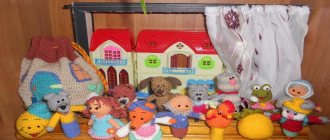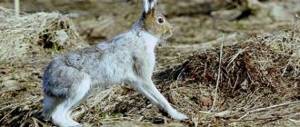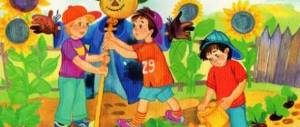Creative project using the technology “Painting with wool”
Municipal educational institution
"Rastsvetskaya secondary school"
Creative project
Heyday, 2016
1. Justification of the project (problems and goals)
Recently, more and more people are trying to please each other with unique gifts. Such a gift should testify to its uniqueness and originality. An oil painting bought in a store is a wonderful gift, but it’s difficult to surprise with them now. Another thing is an original handmade product, made not only in a single copy, but using unusual materials and original techniques.
The wool paintings amazed me, they are so delicate and natural. Wool is an excellent material for work; products made from it are unique and original. Anyone can master painting with wool, even those who don’t know how to draw. That's why I decided to do the work using this technique.
Target:
making a picture from wool.
Tasks:
- Gain theoretical knowledge about wool painting techniques.
- Improve your skills in the field of wool felting using a creative approach to work.
2. Analysis and justification of choice
I decided to make a painting as a gift to decorate the interior and considered three options for manufacturing techniques:
Technique #1: Cross stitch.
Technique No. 2: Embroidery with satin ribbons.
Technique #3: Painting with wool
Technique No. 2
Technique No. 1 Technique No. 2
Technique No. 3
I chose technique for making item No. 3 - painting with wool, as the paintings turn out beautiful and original. Anyone can master this technique, even those who do not know how to draw. When creating this kind of crafts, a person develops motor skills, attentiveness and accuracy. Develops abilities for aesthetic perception. In addition, I have improved my capabilities in project activities.
3. Prototype analysis
During the information gathering process, a number of prototypes were considered.
I decided to make a painting in the still life genre. I liked the white flowers on a dark background; the picture looked very expressive due to the contrasting colors.
4. Description of the product.
The painting is called “Vase with Flowers”. In the center of the picture there is a vase of flowers on the table. White lilies on a dark background.
5. The history of creating paintings from wool.
Wool painting as an artistic movement appeared at the dawn of the 20th century in Germany; its founder was the German philosopher Rudolf Steiner, who chose wool as the most common and cheapest material in the provincial areas.
Knowing the ability of wool to mat, he found a way to use dyed wool as a material for painting. While observing children who regularly used wool as paint, he noticed that the children relaxed psychologically, became more balanced, and their personality acquired a more holistic status.
For about 100 years all over the world, “communication” with colored sheep’s wool has helped people cope with mental tension, stress, gain balance, open up creatively and feel a flight of inspiration while painting with wool, because this process is so creatively dynamic! - a person who paints a picture with wool is not limited to any given framework, he always uses the color scheme that corresponds to the needs of his soul, the plot that is closest to his state at the moment.
Felting wool
is a special needlework technique in which a pattern is created from felting wool on fabric or felt. Only natural wool has the ability to mat.
Dry felting
- one of the varieties of this type of needlework, such as wool felting. Only in comparison with wet felting, there is no need to use a soap solution. The craft is formed using special barbed needles, or the wool is simply laid out by hand, as required by the composition. Woolen paintings are in no way inferior in picturesqueness to ordinary painted ones. Using wool to add volume and airiness to a painting is much easier, and much less time is spent on its creation. The picture should be “painted” from the background. Tear off thin, almost transparent strands of wool from the ribbon and place them on the background. The strands should overlap each other - this results in a mixture of colors and smooth transitions from color to color. The wool is dyed in bright colors, which makes for beautiful paintings.
6.Selection of material.
The following were used to make the painting:
- Wool of different colors
- Scissors
- Tweezers
Wooden frame.
7. Technological sequence of painting production.
Safety rules during operation
- While working, the scissors should lie on the right side of the table with the blades closed and the rings facing the person working.
- You need to take and pass the scissors with the blades closed towards you, the rings forward.
- Store tweezers in one place.
- If tweezers or scissors are not needed, you need to put them in their place.
- Do not use rusty or bent scissors or tweezers.
8. Economic justification for the project
To ensure the economic feasibility of making a painting with your own hands, we calculated the costs that would be required to create the product.
500 rubles
Assessing the cost of the painting, we came to the conclusion that we would never find such a unique painting on the market or in a store for the money we spent on materials! The minimum cost of an oil painting in a store is from 2.5 thousand rubles and above. The resulting painting has many advantages. In addition to its attractive price, this painting differs from all others in its uniqueness, grace and originality.
9. Environmental justification for the project.
The work did not require the use of a large amount of resources: energy costs, complex tools, expensive materials, energy-intensive equipment. We used only environmentally friendly materials and believe that no damage was caused to the environment. All materials used to make the painting (cardboard, wool, wooden frame) can be easily recycled. The glass of the frame can be used to make other products.
10. Design analysis of the finished product
The goal of any human activity is to achieve the desired result. In order to objectively evaluate the resulting product and compare it with the desired result, it is necessary to rely on some laws. When creating work, you need to rely on the laws of artistic design, contrast and color design.
- The most important law of artistic design is the unity of form and content.
- In any product, something should be main and something secondary.
11.Advertising
Any needlewoman who at least once sees such a craft will be interested in how to create something similar.
12.Conclusion
Having mastered the technique of painting with wool, you can easily create a unique decorative product.
I really enjoyed working on paintings using this technique; it always puts me in a good mood, because the work brings joy not only to us, but also to our friends, relatives and acquaintances.
Moreover, in modern society, handmade products are in great demand among our acquaintances and friends. Paintings made using this technique look unique and original. They can be used to decorate the interior of an apartment. This will be a great gift.
The goal and tasks that we set were completed.
13. Literature
- M. Mackey “Paintings made of wool and felt.” Moscow. IG "Content", 2012
- https://www.izuminki.com/2014/09/01/kartiny-iz-shersti/
- https://www.docme.ru/doc/123003/proekt-malygina
LiveInternetLiveInternet
We draw the picture “Winter Night” with wool, author of the master class Alexandra Fedorov (TeplieKartini)
| Types of creativity: | Felting > Dry felting |
| Complexity: | average |
| Working hours: | 4 hours |
To make the painting you will need:
- clamp frame (it consists of hardboard (fibreboard), glass, clamps);
- wool (combed ribbon) of different colors - 6 colors are enough for this work: white, blue, light blue, yellow, brown, dark green;
- scissors,
- tweezers (for laying out small foreground details),
- non-woven or flannel - whatever you find (as a backing).
Time to complete the work: 3-4 hours (A4 format: 21*30cm)
STEP 1
Let's disassemble the frame. We put the clamps aside (they will be needed at the very end of the work. We put a backing on the hardboard (fibreboard) - non-woven fabric. It is designed to “hold” the wool fibers on itself. The working surface is ready!
STEP 2
We lay sliver (undyed, unbleached wool) on the prepared surface, evenly filling the entire area in any direction. At the same time, we pull the fibers from the wool tape in the form of wide thin strands (as shown in the photo Step 3)
This stage is necessary to form the base layer of the painting, as well as to “feel” the wool (in my latest works, I do not use a sliver, I immediately lay out colored wool)
STEP 3
This method of working with wool is called "pulling". Indeed, it turns out that we pull wool fibers from a combed ribbon, which we hold in one hand, with the fingers of the other hand, forming thin strands.
To make it more clear, I show it on dark wool.
STEP 4
Having laid out the working surface with a layer of sliver, we begin to form the background of the picture. At the same time, we use another method of working with wool - “pinching” (see step 5)
STEP 5
The method of “pinching” wool is implemented as follows: we take in one hand a combed ribbon of the color we need, and in this case we take exactly the fold of the ribbon (see photo); With the fingers of the other hand, we pinch the surface hairs of the tape with frequent quick movements. A fluffy ball forms in our hands, which we lay out on the work surface.
STEP 6
We use blue and blue wool to form the background (background) of the picture. We also use the pinching method.
STEP 7
We continue to draw the background. Using white wool, we highlight the middle of the picture, creating something like a haze.
STEP 8
Using the pulling method, we form strands from which we make snowdrifts. We use white and blue wool.
STEP 9
Using white wool we determine the place for the moon. It will be a halo of light emanating from it.
STEP 10
We add strands of yellow wool here and there to make the moonlight warm. We form the moon itself by cutting white wool. Those. We take a strand of wool and cut it thin enough so that the length of the hairs is 2-3mm. And place the resulting fluff onto the picture with tweezers, forming a circle.
STEP 11
Using white wool we draw trees in the distance. At the same time, we cut the wool directly onto the picture, using tweezers we correct what did not lie “correctly.”
STEP 12
Fill the horizon with a forest of white snow-covered trees, as described in step 11.
STEP 13
Let’s make the picture “warmer” by adding yellow wool to the snow.
STEP 14
Use brown wool to draw the frame of the house (you can “cut” the brown wool or roll a strand of wool into a ball and lay it on the surface). Use yellow wool to draw a window. White wool will help give our house a finished look - let's draw a snowy roof and a snowdrift at the base of the house.
STEP 15
We combine dark green, blue and brown wool into one thick strand, then cut this strand onto the picture, forming a Christmas tree. (a non-uniform color of the tree is preferable - it looks more natural)
STEP 16
Use white wool to draw snow on the Christmas tree, using the same technique as in the previous step.
STEP 17
We draw tree trunks with brown wool. To do this, pull out thin long strands and twist them slightly. We draw branches in the same way.
STEP 18
Use white wool to make highlights on the trees
STEP 19
We cut the white wool and place the fluff on tree branches. I tried to depict young pine trees dusted with snow
STEP 20
To the left of the moon we will draw a couple of trees. We form trunks and branches by twisting thin strands of brown wool, you can add a little white (highlight).
STEP 21
Use white wool to draw snowy branches. It is better to cut the wool directly onto the picture, forming the desired shape with tweezers.
STEP 22
Using yellow wool we will make a “moon path” in the snow, it should be quite “blurred”, and we will also make the moon, one side of the Christmas tree and the crown of the pine trees a little yellower. Using blue wool we will make the shadow of the Christmas tree as shown in the photo.
We cover the finished picture with glass (be sure to clean the glass before doing this; for example, I use napkins to clean displays). We clamp with clamps
glass and hardboard with a woolen picture between them, trim off the excess wool protruding along the edges. The finished painting can be framed into a baguette.
And this, in fact, is the picture already under glass (it somehow appears brighter under it) in a frame:
- If you want to add “magic” to the winter landscape, draw snowflakes (snow flakes). This is very easy to do. Pull out a thin strand of white wool (you can add a little blue - the flakes will be more voluminous), twist it a little (so that it is more rounded on the cut) and cut it into the picture. It turns out something like this:
(This is one of my first paintings, a kit for independent work was purchased from Nadezhda Putro, she is also the author of this story)
My tips and recommendations for beginners:
- The more you like the plot that you embody in your painting, the more successful the painting itself will be and the more exciting the process will be. Therefore, it is very important what emotions are evoked by the photograph or picture that you focus on when creating your masterpiece. For work, try to choose the stories that are sweetest to your heart - success in this case is guaranteed
- Wool is a very responsive, rewarding material; it can be figuratively compared to plasticine, because you immediately feel and see what a strand of wool transforms into in your hands. I like to mix different colors of wool, twist it, roll it into balls, cut it and do other manipulations with wool - I know for sure that I am insured against mistakes so that it doesn’t work out. Remember: You can always make “edits”, otherwise the picture will lose its freshness and lightness and become “tormented”.
- If you have a limited choice of wool colors, this is not a problem. Wool of one color, when mixed with wool of another color, like paints, forms shades of varying degrees of uniformity. By using the shades obtained by mixing primary colors, you can create an amazing picture. For example, I really like contrasting things. Having only 2 colors of wool available, you can create a complete picture (for example, dark blue and white wool is enough to “paint” a gorgeous night landscape). As my mother says: “The need for invention is cunning” (about someone’s ingenuity, especially when funds are tight)
- To “paint” pictures with wool, it doesn’t matter at all whether you know how to draw or not. The main thing in this matter is to have “perseverance” (many, by the way, find it convenient to lay out pictures while standing) and have a great desire to make something beautiful with your own hands. In short, this is a craft for the patient and active.
- Do not try to copy the image (photo) exactly; use it only as a sample and source of inspiration. You have your own individual vision of this plot, right?! You, as a creator, as a creator, have the right to place your own accents in this plot (add or remove some details in the foreground, slightly or completely change the background (background) of the picture, choosing the colors and shades of wool that are most suitable in this case)
- To speed up the natural felting of the wool, it is useful to periodically, while laying out the picture, gently slam it with your palm to fasten the layers together.
- Don’t forget to touch the glass to the work surface more often - this way you can very quickly detect flaws in your work and quickly correct them. After all, the end result is a picture of wool under glass, therefore, when working with wool, you need to focus on the image that you see under the glass. The glass serves as an indicator; by applying it to the layers that have already been laid out, you will see how well these layers of wool lie (you can see, for example, that the layer is not dense enough and does not cover the work surface well) or you can see how small details look under the glass (usually , with and without glass everything looks different). Wool is very voluminous; when you press it with glass, the details of the picture “flatten” and thereby increase in size. It often happens that you lay down a thin stem, but when you apply the glass, you realize that it turned out to be too big for this flower and you have to “reduce it”. Only later, with experience, does one understand what a particular part will look like under glass, and one can no longer use this kind of indicator so often to monitor the effectiveness of one’s work.
- For paintings with a dark background (dark blue, black, brown, etc.), it is convenient to use black non-woven fabric as a backing. In this case, you can start laying out the picture not from the sliver, but immediately from colored wool of the dark color you need. This saves a lot of effort and time, as well as the material itself (wool).
- Every object in your painting has shadows, or highlights, or light and dark spots/sides of the object, at least they must be there, otherwise the object will not have volume. When laying out a picture, try to shade parts of the objects with the appropriate color of wool for the occasion, create highlights on the vases (it’s glass!), and always try to enliven the picture by using the play of light and shadow. It is very important! I sometimes worry a lot about this. The husband comes and asks: “Will you finish soon? It's already late." And I told him: “My river doesn’t flow, my flowers don’t bloom!” The most difficult thing is when you need to convey exactly the “living” properties of objects. At the same time, it should look quite fresh, and not tortured.
I WISH YOU SUCCESS!!!






